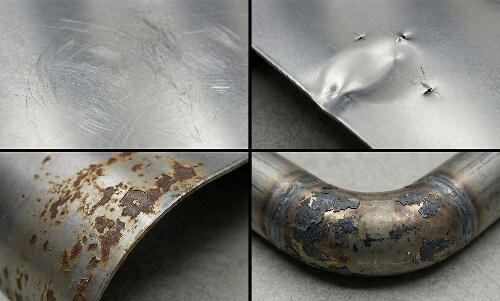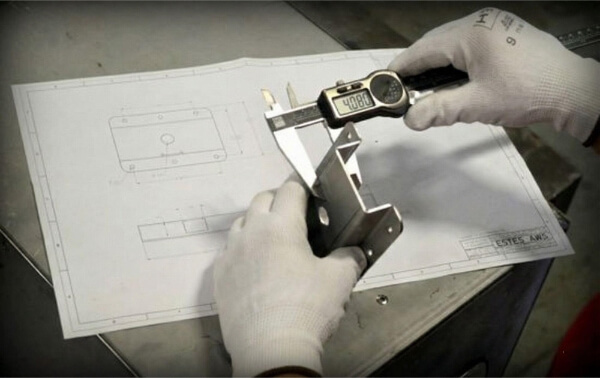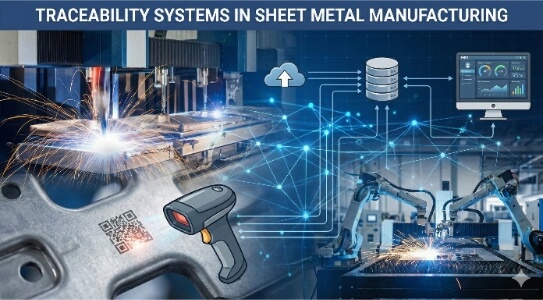Металлические детали постоянно подвергаются угрозе ржавчины и коррозии, что приводит к дорогостоящей замене и обслуживанию. Традиционные защитные покрытия часто не справляются с этой задачей, быстро изнашиваясь или обеспечивая недостаточное покрытие. Покрытие Dacromet решает эти проблемы благодаря уникальному цинково-алюминиевому составу, обеспечивая превосходную защиту в различных областях промышленности.
Хотите узнать, как эта передовая технология нанесения покрытия может продлить срок службы ваших деталей и сократить расходы на долгосрочное обслуживание? Давайте рассмотрим технические детали, преимущества и лучшие способы применения покрытия Dacromet.
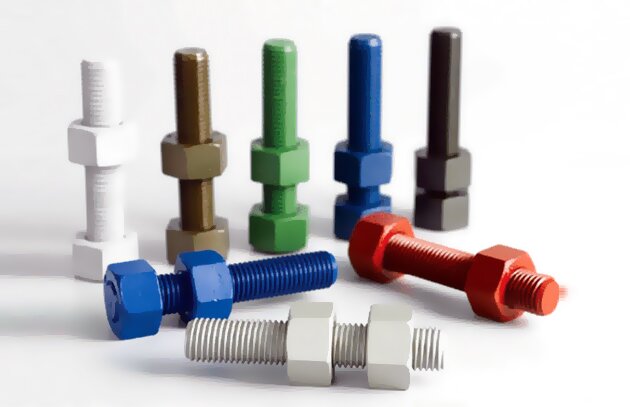
Что такое дакрометаллическое покрытие?
Покрытие Dacromet сочетает в себе хлопья цинка, алюминиевую пудру и неорганические соединения в растворе на водной основе. Эта передовая система покрытия образует многослойный барьер благодаря точному процессу нанесения методом погружения и последующему высокотемпературному отверждению.
Считайте, что вы создаете защиту для металлических поверхностей - но более умную, чем традиционные покрытия. Процесс начинается с погружения деталей в смесь для покрытия, их вращения для обеспечения равномерного покрытия, а затем отверждения при температуре около 300°C. В результате образуется защитный слой толщиной около 7-8 мкм.
Частицы цинка выступают в роли жертвенных защитников, принимая на себя удар коррозионных элементов до того, как они достигнут основного металла. Алюминиевые хлопья создают физический барьер, а неорганическое связующее фиксирует все на месте, контролируя жертвенное действие цинка.
Виды дакрометаллических покрытий
Для разных областей применения требуются различные уровни защиты и особые эксплуатационные характеристики. Производители предлагают несколько вариантов покрытия Dacromet, каждый из которых предназначен для определенных областей применения и условий окружающей среды.
Базовый слой - это основа, состоящая из цинково-алюминиевых хлопьев, смешанных со специальными связующими веществами для создания защитного слоя серебристого цвета. Эта базовая формула создает основу для более специализированных покрытий.
Вот основные типы:
Серия Dacromet:
- 310/320: Идеально подходит для крепежные детали и пружиныс использованием состава на основе шестивалентного хрома
- 500: Обладает самосмазывающимися свойствами, идеально подходит для автомобильных и ветроэнергетических компонентов
Серия Geomet (без хрома):
- 720: Создан для крепежа и автомобильных деталей с использованием технологии на основе силикатов
- 321: Обеспечивает надежную защиту в строительстве и автомобильной промышленности
- 500: Включает в себя самосмазывающиеся свойства для снижения трения
- 320/360: Содержит повышенное количество алюминия для обеспечения высокой термостойкости, специально разработан для деталей тормозов
Процесс нанесения покрытия Dacromet
Превращение необработанных металлических деталей в устойчивые к коррозии компоненты требует точного контроля и специализированного оборудования. Успешный процесс нанесения покрытий требует пристального внимания к материалам, методам нанесения и мерам контроля качества.
Материалы, используемые для нанесения покрытия Dacromet
Выбор подходящих материалов имеет решающее значение для создания эффективного покрытия Dacromet. Каждый компонент играет определенную роль в конечном защитном слое.
Основные материалы включают:
- Цинковые хлопья: Основной ингибитор коррозии
- Алюминиевая пудра: улучшает барьерные свойства
- Неорганические связующие вещества: Фиксируют металлические частицы на месте
- Специализированные добавки: Контроль вязкости и текучести
- Носители на водной основе: Обеспечивают равномерное распределение
Пошаговый процесс нанесения покрытия Dacromet
Процесс нанесения покрытия проходит в четкой последовательности:
Подготовка поверхности
- Тщательно очистите детали, чтобы удалить масла и загрязнения
- Дробеструйная или химическая обработка поверхностей для оптимальной адгезии
- Проверьте детали на чистоту и профиль поверхности
Нанесение покрытия
- Окуните детали в раствор Дакромет
- Вращение на контролируемой скорости для равномерного покрытия
- Обеспечьте первоначальную воздушную сушку в контролируемых условиях
Процесс отверждения
- Нагрейте детали примерно до 300°C
- Поддержание температуры в течение определенного времени
- Охлаждение в контролируемых условиях
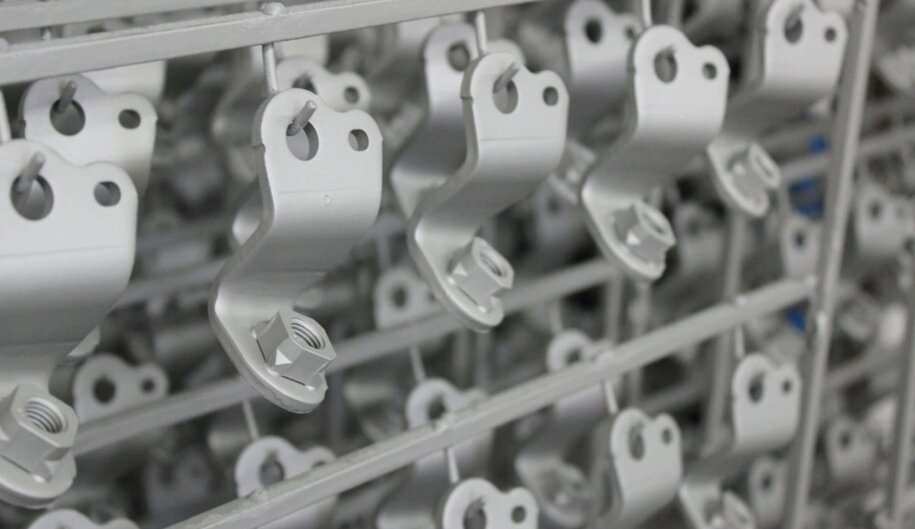
Преимущества покрытия Dacromet
Технологии защиты металла продолжают развиваться, и покрытие Dacromet выделяется своими комплексными преимуществами. В этом разделе рассматриваются ключевые преимущества, которые делают Dacromet предпочтительным выбором для защиты металла в различных отраслях промышленности.
Повышенная коррозионная стойкость
Покрытие Dacromet создает многочисленные барьеры против коррозионных элементов благодаря своей уникальной слоистой структуре. Цинково-алюминиевые чешуйки образуют непроницаемый экран, блокирующий проникновение влаги, соли и химических веществ.
Основные функции защиты:
- Выдерживает 1 000+ часов испытаний в соляном тумане
- Предотвращает образование красной ржавчины
- Стойкость к химическому воздействию в промышленных условиях
Повышенная прочность и долговечность
Многослойная структура покрытия Dacromet значительно увеличивает срок службы компонентов. Такая долговечность приводит к сокращению частоты замены и снижению эксплуатационных расходов.
Показатели эффективности:
- Срок службы 20+ лет в нормальных условиях
- Высокая износостойкость
- Сильная адгезия к цветным металлам
Устойчивость к высоким температурам
Дакромет сохраняет свои защитные свойства в широком диапазоне температур. Такая термостойкость делает его пригодным для компонентов, подверженных термоциклированию.
Температурные характеристики:
- Стабильность до 300°C (572°F)
- Не размягчается и не трескается под воздействием тепла
- Сохраняет адгезию при перепадах температуры
Экологически чистые аспекты покрытия Dacromet
Процесс нанесения покрытия соответствует современным экологическим стандартам. Его состав на водной основе и методы производства снижают воздействие на окружающую среду.
Зеленые преимущества:
- Нулевые выбросы летучих органических соединений
- Соответствует требованиям REACH и RoHS
- Перерабатываемые детали с покрытием
Низкие требования к обслуживанию
После нанесения покрытие Dacromet требует минимального ухода. Самовосстанавливающиеся свойства цинка обеспечивают постоянную защиту без регулярного ухода.
Преимущества в обслуживании:
- Нет необходимости в периодическом повторном покрытии
- Самостоятельное устранение мелких царапин
- Сохраняет внешний вид на протяжении долгого времени
Недостатки покрытия Dacromet
Ограниченная эстетическая привлекательность
Покрытие дает серую матовую поверхность, которая может подойти не для всех областей применения. По сравнению с другими типами покрытий, выбор цветов остается ограниченным.
Уязвимость к механическим повреждениям
Несмотря на свои защитные свойства, покрытие Dacromet может быть повреждено в результате сильного удара или истирания. Острые предметы или тяжелые грузы также могут нарушить целостность покрытия.
Более длительное время отверждения по сравнению с другими покрытиями
Процесс многослойного нанесения требует особых условий и времени отверждения. Это увеличивает сроки производства по сравнению с более простыми методами нанесения покрытий.
Возможность неравномерной толщины покрытия
Техника нанесения влияет на однородность покрытия. Сложная геометрия деталей может привести к изменению толщины, что влияет на уровень защиты.
Более высокая первоначальная стоимость применения
Специализированное оборудование и контроль процесса, необходимые для нанесения покрытия Dacromet, приводят к увеличению первоначальных затрат. Эти первоначальные инвестиции должны быть сопоставлены с долгосрочными преимуществами.
Области применения дакрометаллических покрытий
Покрытие Dacromet используется во многих отраслях промышленности, где защита металла от неблагоприятных условий окружающей среды имеет решающее значение. Это универсальное покрытие отвечает специфическим требованиям к эксплуатационным характеристикам в различных отраслях, от автомобильной до морской.
Применение в автомобильной промышленности
Автомобильный сектор в значительной степени полагается на покрытие Dacromet для защиты критически важных компонентов от дорожной соли, влаги и воздействия окружающей среды. Это покрытие помогает производителям соблюдать строгие стандарты долговечности и сокращать количество гарантийных случаев.
Обычное автомобильное применение:
- Компоненты тормозной системы
- Детали подвески
- Крепежные элементы шасси
- Кронштейны крепления двигателя
- Компоненты топливной системы
Аэрокосмическое и военное применение
В аэрокосмической и оборонной промышленности покрытие Dacromet отвечает строгим техническим требованиям. Покрытие защищает компоненты, подвергающиеся воздействию экстремальных условий и переменчивого климата.
Основные области применения в военной и аэрокосмической промышленности:
- Конструкционный крепеж
- Компоненты шасси
- Внешнее оборудование
- Наземное вспомогательное оборудование
- Монтажные кронштейны
Строительство и инфраструктурные проекты
Строительная отрасль ценит покрытие Dacromet за его долговременную защиту конструктивных элементов. Это покрытие помогает продлить срок службы инфраструктуры в сложных условиях.
Применение в строительстве включает:
- Компоненты моста
- Дорожные ограждения
- Строительный крепеж
- Вспомогательные структуры
- Деформационные швы
Морские применения
Морская среда требует превосходной защиты от коррозии. Покрытие Dacromet обеспечивает превосходную устойчивость к солевому туману и постоянному воздействию влаги.
Морской сектор использует:
- Палубная фурнитура
- Портовое оборудование
- Морские платформы
- Судовая арматура
- Компоненты контейнера
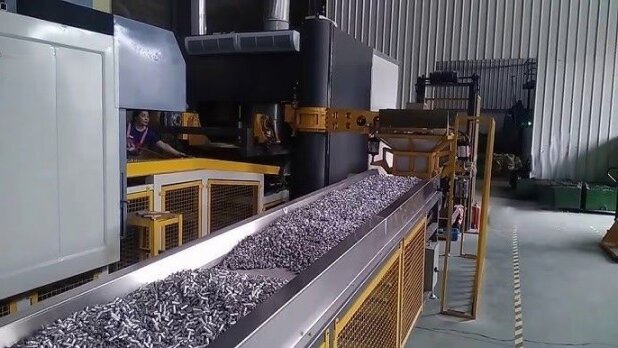
Покрытие Dacromet по сравнению с покрытием Dacromet. Цинкование
Правильный выбор между вариантами покрытий влияет как на производительность, так и на стоимость. Данное сравнение помогает лицам, принимающим решения, выбрать наиболее подходящее решение для своих конкретных нужд.
Критические различия в коррозионной стойкости
Два метода нанесения покрытия обеспечивают разные уровни защиты от коррозионной среды. Испытания показали значительные различия в производительности в сложных условиях.
Сравнение коррозионной стойкости:
- Дакромет: Стойкость к воздействию соляного тумана в течение 1 000+ часов
- Цинковое покрытие: Устойчивость к воздействию соляного тумана в течение 200-300 часов
Механизмы защиты:
- Дакромет создает несколько барьерных слоев
- Цинкование полагается на жертвенную защиту
- Риски воздействия цветных металлов существенно различаются
Экономическая эффективность
Первоначальные затраты и долгосрочная стоимость представляют собой различные экономические сценарии для каждого типа покрытия. Тщательный анализ позволяет выявить истинное влияние затрат с течением времени.
Необходимо учитывать факторы стоимости:
Дакромет:
- Более высокие первоначальные инвестиции
- Снижение затрат на техническое обслуживание
- Увеличенный срок службы
Цинковое покрытие:
- Более низкие первоначальные затраты
- Требуется более частое повторное покрытие
- Более высокие долгосрочные расходы
Сравнение долговечности и производительности
В реальных условиях эксплуатации эти варианты покрытий значительно отличаются друг от друга. Условия окружающей среды и требования к нанесению влияют на долговечность покрытия.
Показатели эффективности:
Температурная устойчивость:
- Дакромет: До 300°C
- Цинковое покрытие: До 120°C
Консистенция по толщине:
- Дакромет: Равномерное покрытие
- Цинковое покрытие: Переменное наращивание
Устойчивость к ударам:
- Дакромет: Умеренная гибкость
- Цинковое покрытие: Более хрупкий
Химическая стойкость:
- Дакромет: Высокое сопротивление
- Цинковое покрытие: Умеренное сопротивление
Заключение
Покрытие Dacromet доказывает свою ценность благодаря превосходной защите от коррозии и долгосрочной выгоде. Хотя первоначальные инвестиции могут быть выше, увеличенный срок службы и сокращение технического обслуживания делают его разумным выбором для сложных условий эксплуатации. Соответствие покрытия экологическим нормам и проверенная временем репутация в различных отраслях промышленности делают его надежным решением для современных производственных задач.
Помимо нанесения покрытия Dacromet, мы предлагаем комплексные решения по изготовлению продукции на заказ для любых ваших нужд. Благодаря современному оборудованию и профессиональной технической команде мы можем удовлетворить ваши разнообразные требования в следующих областях обработка с ЧПУ, изготовление листового металлаи многое другое. Выбирайте нас, чтобы сделать ваш производственный процесс более эффективным и бесперебойным.
Часто задаваемые вопросы
Как долго служит покрытие Dacromet?
При нормальных условиях покрытие Dacromet обычно служит 20-25 лет. Фактический срок службы зависит от воздействия окружающей среды и условий применения. Регулярные проверки помогают контролировать работу покрытия с течением времени.
Можно ли наносить покрытие Dacromet на все материалы?
Покрытие Dacromet лучше всего работает на стальных и железных субстратах. Хотя его можно наносить и на другие металлы, процесс нанесения покрытия требует особых условий и методов подготовки поверхности для обеспечения надлежащей адгезии.
Является ли покрытие Dacromet экологически безопасным?
Состав на водной основе не содержит тяжелых металлов и вредных растворителей. Покрытие Dacromet соответствует современным экологическим нормам во всем мире, включая стандарты REACH и RoHS. В процессе производства образуется минимум отходов и выбросов.
Содержит ли Dacromet шестивалентный хром?
Нет, покрытие Dacromet не содержит шестивалентного хрома. Вместо него используются соединения трехвалентного хрома, что делает его соответствующим современным стандартам экологии и безопасности.
Какова толщина покрытия на Dacromet?
Стандартная толщина покрытия Dacromet варьируется от 5 до 15 микрон. Точная толщина зависит от требований к применению и указанного уровня качества. Меры контроля качества обеспечивают постоянную толщину покрытия на всех деталях.
Привет, я Кевин Ли

Последние 10 лет я занимался различными формами изготовления листового металла и делился здесь интересными идеями из своего опыта работы в различных мастерских.
Связаться

Кевин Ли
У меня более десяти лет профессионального опыта в производстве листового металла, специализирующегося на лазерной резке, гибке, сварке и методах обработки поверхности. Как технический директор Shengen, я стремлюсь решать сложные производственные задачи и внедрять инновации и качество в каждом проекте.

